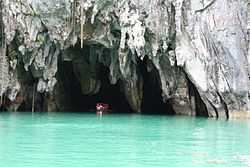Subterranean river

A subterranean river is a river that runs wholly or partly beneath the ground surface – one where the riverbed does not represent the surface of the Earth (rivers flowing in gorges are not classed as subterranean[1]).
Subterranean rivers may be entirely natural, flowing through cave systems. In karst topography, rivers may disappear through sinkholes, continuing underground. In some cases, they may emerge into daylight further downstream. Some fish (such as the Amblyopsidae) and other troglobite organisms are adapted to life in subterranean rivers and lakes.[2]
Subterranean rivers can also be the result of covering over a river and/or diverting its flow into culverts, usually as part of urban development.[3] Reversing this process is known as daylighting a stream and is a visible form of river restoration. One successful example is the Cheonggye Stream in the centre of Seoul.[4][5]
Examples of subterranean rivers also occur in mythology and literature.
Natural examples

There are many natural examples of subterranean rivers. Among others:
- The Križna cave system in Loška Dolina, Slovenia includes 22 subterranean lakes
- The Lost River in the Appalachian Mountains of West Virginia disappears underground and reappears as the Cacapon River
- The Mojave River in southern California flows underground in most places
- The Phong Nha-Kẻ Bàng National Park in Vietnam has an underground river flowing through its cave system
- The Puerto Princesa Subterranean River on the island of Palawan, Philippines flows underground before emerging into the South China Sea
- The Santa Fe River in northern Florida drops into a large sinkhole in O'Leno State Park and reappears in the adjacent River Rise Preserve State Park, 3 miles (4.8 km) downstream
- The Sistema Sac Actun is an underwater cave system near the Caribbean coast of the Yucatán Peninsula
- The Río Secreto system of caves, formed over centuries by an underground river is located in the Riviera Maya, Yucatán Peninsula.
Artificial examples

In many cities there are natural streams which have been partially or entirely built over. Such man-made examples of subterranean urban streams are too numerous to list, but notable examples include:
- The Dommel underneath 's-Hertogenbosch in the Netherlands
- The Fleet and other subterranean rivers of London
- The Frome underneath Bristol
- The Hobart Rivulet in Tasmania
- The Neglinnaya River, which runs through a series of tunnels underneath the central part of Moscow
- The Tank Stream underneath Sydney, Australia
- The River Team underneath the Team Valley Trading Estate, Gateshead, United Kingdom
- The Zenne underneath Brussels, following the covering of the Zenne between 1865 and 1871
- The Bièvre underneath Paris, France
- Castle Frank Brook, Garrison Creek, Russell Creek, and Taddle Creek, and other subterranean urban streams in Toronto
Ecology
Some fish (such as the Amblyopsidae) and other troglobite organisms are adapted to life in subterranean rivers and lakes.
Mythology and literature
Greek mythology included the Styx, Phlegethon, Acheron, Cocytus, and Lethe as rivers within the Underworld. Dante Alighieri, in his Inferno, included the Acheron, Phlegethon, and Styx as rivers within his subterranean Hell. The river Alph, running "Through caverns measureless to man / Down to a sunless sea" is central to the poem Kubla Khan, by Samuel Taylor Coleridge.
The characters in Jules Verne's A Journey to the Centre of the Earth encounter a subterranean river:
"Hans was not mistaken," he said. "What you hear is the rushing of a torrent."
"A torrent?" I exclaimed.
"There can be no doubt; a subterranean river is flowing around us."[6]
Several other novels also feature subterranean rivers.[3] The subterranean rivers of London feature in e.g. the novel "Drowning Man" by Michael Robotham as well as in the novel Thrones, Dominations by Dorothy L. Sayers and Jill Paton Walsh in which a character remarks:
"You can bury them deep under, sir; you can bind them in tunnels, ... but in the end where a river has been, a river will always be."[7]
See also
- Hamza River
- Abîme
- Karst topography
- Losing stream
- Speleology
- Subterranean rivers of London
- Subterranean rivers of Hong Kong
- Toronto ravine system
- Hamilton ravine system
- Underground lake
References
| Wikimedia Commons has media related to Underground rivers and lakes. |
- ↑ William Herbert Hobbs, Earth Features and Their Meaning: An Introduction to Geology for the Student and the General Reader, Macmillan, 1912, pages 182 and 189.
- ↑ William B. White and David C. Culver (eds), Encyclopedia of Caves, 2nd ed, Academic Press, 2012, ISBN 0123838339, p. 468.
- ↑ 3.0 3.1 Richard J. Heggen: Underground Rivers from the River Styx to the Rio San Buenaventura with Occasional Diversions, University of New Mexico.
- ↑ Revkin, Andrew C. (16 July 2009). "Rolling Back Pavement to Expose Watery Havens". New York Times. Retrieved 16 March 2010.
- ↑ Kirk, Donald (2005-10-13). "Seoul peels back concrete to let a river run freely once again". World>Asia Pacific (The Christian Science Monitor). Retrieved 2006-08-21.
- ↑ Jules Verne, A Journey to the Center of the Earth, translated by Frederick Amadeus Malleson, 1877, at Project Gutenberg.
- ↑ Dorothy L. Sayers and Jill Paton Walsh, Thrones, Dominations, Hodder and Stoughton, 1998, p. 313.
| ||||||||||||||||||||||||||||
.jpg)